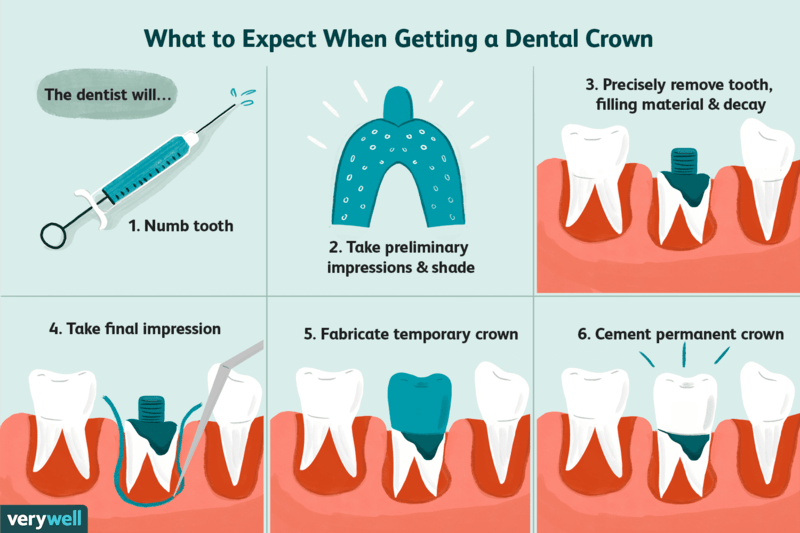
Dental crowns, a popular solution for damaged teeth, undergo a meticulous attachment process. The initial step involves preparing the tooth by removing decay and reshaping it. A custom crown is crafted from an impression, offering a perfect fit. During the fabrication period, a temporary crown safeguards the prepared tooth. Upon completion, the permanent crown is attached using dental cement. The dentist ensures proper fit and bite alignment. With careful maintenance, dental crowns offer long-lasting, natural-looking restorations. This comprehensive guide details each step, providing insights into the intricate procedure of attaching dental crowns.
:max_bytes(150000):strip_icc()/numbing-the-tooth-in-a-dental-crown-procedure-1059036_final-788dfa05acf24255aa0d406f45df1b31.png)
How Are Dental Crowns Attached?
Dental crowns are an effective solution for restoring damaged teeth. They can improve both the function and aesthetics of your smile. But have you ever wondered how dental crowns are attached? In this article, we will explore the process of attaching dental crowns and discuss what you can expect during this procedure.
The Procedure for Attaching Dental Crowns:
- Tooth Preparation:
- Decay and existing filling material removal ensures a clean tooth surface.
- Reshaping, involving size reduction or building up with filling material, prepares the tooth for crown placement.
- Impressions and Temporary Crown:
- Impressions capture tooth details for crafting a custom-made crown.
- A temporary crown safeguards the prepared tooth while the permanent one is created in a dental laboratory.
- Permanent Crown Placement:
- Removal of the temporary crown precedes a fit and appearance check for the new crown.
- Adjustments are made if necessary, and dental adhesive is used for bonding, ensuring proper alignment with other teeth.
Benefits of Dental Crowns:
- Strength and Protection:
- Dental crowns fortify weakened teeth, enabling confident biting and chewing.
- They provide essential protection to damaged teeth, enhancing overall dental health.
- Aesthetic Improvements:
- Crowns cover imperfections like discoloration or misshapen teeth, improving smile aesthetics.
- Restoration of natural tooth shape and alignment contributes to an enhanced overall oral appearance.
How Long Do Dental Crowns Last?
- Lifespan Factors:
- Crown material and type significantly influence longevity.
- Proper oral care practices, including regular dental check-ups, play a vital role in extending the lifespan of dental crowns.
- Average Lifespan:
- Dental crowns typically have a lifespan of 10 to 15 years.
- With diligent maintenance and care, crowns can surpass the average lifespan, emphasizing the importance of consistent oral hygiene practices.
Tips for Caring for Dental Crowns
To keep your dental crowns in good condition, here are a few tips to follow:
1. Practice good oral hygiene: Brush your teeth twice a day and floss daily to remove plaque and prevent gum disease.
2. Avoid chewing hard or sticky foods: Dental crowns are strong, but they can still be damaged by excessive force. Avoid biting into hard foods or chewing on objects like ice or pens.
3. Wear a mouthguard: If you participate in sports or grind your teeth at night, wearing a mouthguard can protect your dental crowns from damage.
4. Visit your dentist regularly: Regular dental check-ups allow your dentist to monitor the condition of your dental crowns and make any necessary adjustments or repairs.
By following these tips, you can ensure that your dental crowns remain in great shape for years to come.
Conclusion
Attaching dental crowns is a multi-step process that involves careful preparation, custom creation, and precise attachment. Dental crowns offer several benefits, including improved oral function and an enhanced smile. By following good oral hygiene practices and caring for your dental crowns properly, you can enjoy the benefits of your new restoration for many years. Visit your dentist regularly for check-ups and maintenance to keep your dental crowns in optimal condition.
Key Takeaways: How Are Dental Crowns Attached?
- Dental crowns are attached to damaged or decayed teeth to restore their shape and function.
- The process involves preparing the tooth, taking impressions, and placing a temporary crown.
- The permanent crown is custom-made in a dental lab using materials like porcelain or metal.
- During the final appointment, the temporary crown is removed and the permanent crown is cemented onto the tooth.
- After attachment, dental crowns can last for many years with proper oral hygiene and regular dental check-ups.
Frequently Asked Questions
Here are some common questions about how dental crowns are attached:
How are dental crowns attached to the teeth?
Dental crowns are attached to the teeth using a strong dental adhesive. Before attaching the crown, the dentist will prepare the tooth by removing any decay or old fillings and shaping it to fit the crown. An impression of the prepared tooth is then taken to create a custom-made crown that matches the shape and color of the surrounding teeth. Once the crown is ready, it is carefully placed over the prepared tooth and bonded with the dental adhesive. The adhesive is cured using a special light to ensure a secure and durable attachment.
The process of attaching a dental crown is usually painless and can be completed in a single visit to the dentist. However, in some cases, such as when a dental implant is used to support the crown, multiple appointments may be required.
Are dental crowns permanent?
Dental crowns are designed to be long-lasting, but they are not considered permanent. On average, a well-maintained dental crown can last between 10 and 15 years. However, the lifespan of a dental crown can vary depending on factors such as oral hygiene practices, the material used for the crown, and the bite forces exerted on the crown. It is important to maintain good oral hygiene, including regular brushing, flossing, and dental check-ups, to ensure the longevity of a dental crown.
If a dental crown becomes loose or damaged, it can often be repaired or replaced by a dentist. Regular dental examinations can help detect any issues with dental crowns early on and prevent further complications.
Can dental crowns be removed?
Dental crowns are intended to be permanent restorations and are not meant to be removed on a regular basis. However, there are situations where a dental crown may need to be removed. For example, if there is decay or damage underneath the crown, it may need to be removed to address the underlying issue. In some cases, a dental crown may also be removed to make adjustments or replace it with a new crown.
Removing a dental crown typically requires the expertise of a dentist. The crown is carefully removed using dental instruments, and any underlying issues are addressed before a new crown can be placed. It is important to seek professional dental care if you have any concerns or issues with a dental crown.
Do dental crowns require special care?
Dental crowns do not require special care beyond regular oral hygiene practices. It is important to brush your teeth twice a day with a soft-bristle toothbrush and fluoride toothpaste. Flossing daily and using an antibacterial mouthwash can also help maintain the health of your dental crown and surrounding teeth.
Additionally, it is recommended to avoid biting on hard objects or using your teeth as tools, as this can potentially damage the crown. Regular dental check-ups and professional cleanings are also essential to monitor the condition of the dental crown and ensure its longevity.
Can dental crowns be whitened?
Dental crowns cannot be whitened using traditional teeth whitening methods. The color of a dental crown is determined during the fabrication process and cannot be altered once it is attached to the tooth. If you are considering teeth whitening, it is recommended to do it before getting a dental crown to ensure a consistent color match with your natural teeth.
If you have existing dental crowns that have become discolored or no longer match your desired tooth shade, you may discuss with your dentist the possibility of replacing the crowns with new ones that better match your desired aesthetics.
Final Summary: How Are Dental Crowns Attached?
Call or Book appointment online
:Ace Dental Care Alpharetta office: 678-562-1555 - Book Now
Ace Dental Care Norcross office: 770-806-1255 - Book Now
Disclaimer
This blog post was generated by artificial intelligence. The content of this post may not be accurate or complete, and should not be relied upon as a substitute for professional advice. If you have any questions about the content of this post, please contact us.
We are constantly working to improve the accuracy and quality of our AI-generated content. However, there may still be errors or inaccuracies. We apologize for any inconvenience this may cause.





